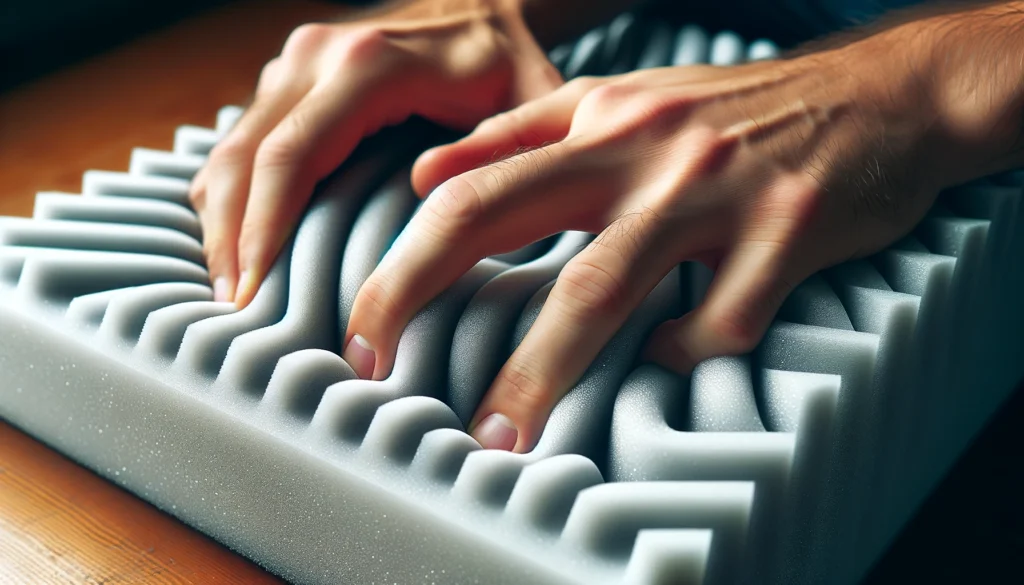Decompressing acoustic foam properly before installation is crucial for ideal noise reduction.
Acoustic foam arrives compressed for shipping and requires time to fully expand back to size.
Let’s dive into exactly how long decompression takes and techniques to help acoustic foam panels regain shape.
How Long Should You Wait Before Installing Acoustic Foam?

Acoustic foam typically requires 1 to 7 days to naturally decompress and return to proper size.
Do not install foam while still compressed or performance will suffer.
Allow panels to lay flat as air pockets inflate. Carefully check the foam each day of the decompression period until reaching the expected dimensions.
Now let’s explore more details on the acoustic foam decompression process.
What is Acoustic Foam and Why It May Need Decompressing

Acoustic foam is a special type of foam used for sound absorption and acoustic treatment purposes.
It helps to improve sound quality by reducing echo, reverberation, and background noise in a room.
Acoustic foam comes packaged very tightly and compressed for shipping and storage purposes.
When it arrives, acoustic foam will be squeezed and compacted into a fraction of its normal size.
Therefore, before installing acoustic foam panels, it is very important to allow enough time for the foam to fully decompress and return to its proper dimensions.
If acoustic foam is installed while still compressed, it will not perform as intended, and likely fail to treat the room’s acoustic properly.
Decompressing gives the foam time to expand back to its normal shape and volume.
Properly decompressed foam will be springy, hold its form better, and have visible air pockets throughout.
Decompressed foam panels can then be securely installed onto walls or ceilings as acoustic treatment.
Allowing Time for Natural Decompression

It is important not to try to speed up the decompression process by kneading, bending, or pulling on the acoustic foam.
This risks permanently damaging the foam and can impact its acoustic performance.
Instead, the foam should be left to decompress naturally over time.
After unpacking compressed acoustic foam, lay the full panels flat and allow them to remain uncompressed.
Given adequate space and time, the foam will slowly expand back to its normal specifications.
Most acoustic foam requires between 1 to 7 days to fully decompress and relax.
The time it takes can vary based on the temperature and humidity levels.
Warmer environments between 60 to 80 degrees Fahrenheit along with 40 to 60 percent relative humidity will help the foam restore itself faster than very hot, very cold, or very humid conditions.
Be sure to check on the progress of the foam daily to see how the expansion is progressing.
However do not excessively handle or disturb the foam while it is off-gassing.
Judging the state of decompression will determine when the acoustic foam is ready for installation.
Methods to Help the Decompression Process

While acoustic foam mainly needs free space and time to decompress, there are a few things that can assist the process.
If the foam panels came stacked or with pieces touching, carefully separate them so air can freely circulate around each piece.
As the foam expands, gently squeezing, massaging, or fluffing parts of it can help open up the cell structure.
Carefully work the foam from the base to the top using your hands.
This guides trapped air pockets upwards, letting them fully inflate.
Avoid pulling on the foam excessively or bending pieces backwards, as too much tension can tear the foam.
For foam layers with one side still compressed, take a large soft brush and lightly brush upwards from the base of the foam.
Using vertical strokes stimulates the foam to stand upright as the bristles lift and separate the cell walls.
The gentle brushing motion helps fluff flattened foam without risking damage by over handling it.
Signs Your Acoustic Foam Has Fully Decompressed

It is important to allow the acoustic foam adequate time to reach its fully expanded state before installation.
Rushing installation of partially decompressed foam will negatively impact performance.
Here are key signs that acoustic foam had completed the decompression process:
– The foam has expanded to reach its expected manufacturer stated dimensions.
Carefully measure width x length x height to confirm it matches what is listed.
– Pressing into the foam reveals a springy, spongy texture. Partially compressed foam feels denser and less giving.
– The foam holds its shape when lifted or moved instead of compressing down under its own weight.
– Inspecting foam cells shows an open air pocket structure with visible channels throughout.
These are indications that acoustic foam has successfully returned to its original uncompressed state after packaging and is ready for installing in the desired location.
What to Do If Foam Doesn’t Reach Full Size

Sometimes foam may fail to fully expand, even when given adequate decompression time.
First, continue allowing more time, as decompressing can take over a week depending on foam density.
Also insure there are no obstructions limiting the foam’s ability to expand.
Carefully inspect for any spots being compressed under weight or touch each other.
Loosen the foam and separate it to allow complete expansion.
Note if there are any specific areas failing to reach maximum listed size, while other sections have fully decompressed.
Target problem sections by working the foam cells more vigorously by massaging or brushing upwards.
If size discrepancies remain after 2 weeks, with some portions 10% under expected measurements, contact the manufacturer about the issue.
This could indicate a defective production batch or shipping damage weakening the foam.
Following these acoustic foam decompression tips correctly prepares panels to perform their essential sound absorber duties.
Allowing enough time for full natural expansion saves acoustic foam from permanent compression damage.
Checking foam periodically until reaching complete dimensions ensures it will fit spaces properly.
With cautious hands-on assistance, foam can decompress faster to its optimal acoustical state.
Conclusion
Following proper acoustic foam decompression techniques helps ensure it regains maximum size, shape, and acoustic performance.
Allowing 1-7 days for natural off-gassing lets trapped air pockets inflate without damage.
Gently working problem areas by hand or with a soft brush can assist expansion.
Confirming foam meets all manufacturer specifications prior to installation results in an effective sound absorption solution.
